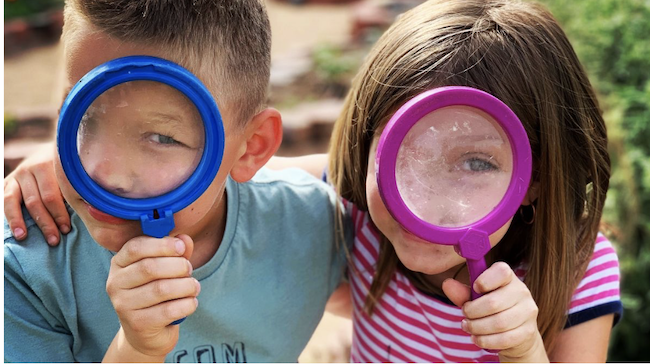
Pollinators
This month we are learning about our good garden friends the pollinators. Who are the pollinators? Bees, hummingbirds, moths, bats, butterflies, flies, and beetles are a few notable representatives.
Pollinators are animals that help many flowering plants produce their seeds and thus ensure the continued existence of millions of plant species, and in turn, of most animal species, including humans.
Each week we will dig into a different pollination-focused topic and provide instructions for engaging, hands-on lessons and activities. By the end of the month we hope your young gardeners will understand the intricate relationship between pollinators and flowering plants and also learn to love, respect, and appreciate these hard-working animals.
Week 1: What is Pollination?
This week kids will learn:
• The common parts of a flower
• How flowers make seeds
• Why many flowers need help from pollinators to make their seeds
Download Week 1 Lessons
• Pollinator Week 1 Full Packet (includes all components listed below)
Week 1 Contents
• Introduction, Activities, and Digging Deeper
• Fantastic Flowers Reading Page
• Anatomy of a Flower coloring page
• Flower Dissection Worksheet
Week 2: Who Are the Pollinators?
This week kids will:
• learn how to identify common pollinators
• discover why different pollinators are attracted to different kinds of flowers
• sharpen their observation skills
Download Week 2 Lessons
• Pollinator Week 2 Full Packet (includes all components listed below)
Week 2 Content
• Introduction, Activities, and Digging Deeper
• Blooming Cafés Reading Page
• Pollinator Flower Profile Cards
• Pollinator Scavenger Hunt
Week 3: Why Do We Need Pollinators?
This week kids will:
• Discover why seeds are so important
• Investigate some of the common fruits and vegetables we eat that rely on pollinators
• Explore all of the ways plants are important in our environment
Download Week 3 Lessons
• Pollinator Week 3 Full packet (includes all components listed below)
Week 3 Content
• Introduction, Activities and Digging Deeper
• Pollinator Food Diary
• Making Seeds Reading Page
Week 4: How can we protect pollinators?
This week kids will:
• Learn about native pollinators and their habitat needs
• Discover reasons why pollinator populations are decreasing
• Explore ways they can help pollinators
Download Week 4 Lessons
• Pollinator Week 4 complete packet(includes all components listed below)
Week 4 Content
• Introduction, Activities, and Digging Deeper
• Helping our Pollinator Friends Reading Page
• Sample Pollinator Garden Plan
Weekly Supply Lists
Week 1 Supply List
• Crayons, colored pencils, or markers
• Plastic cup(s)
• *Modeling clay or playdough (Try your hand at making no-bake homemade playdough or traditional homemade playdough)
• *Construction paper
• *Crayons, colored pencils, or markers
• *Chenille sticks, pipe cleaners, or straws
• *Pompoms, cotton balls, or tissue paper
• *Tape (Note: Feel free to substitute any of the starred supplies if needed. You’ll find more suggestions listed in Activity 2.)
• A sample flower
• Hand lens or magnifying glass (optional)
• Tweezers (optional)
Week 2 Supply List
• Crayons, colored pencils or markers
• Clipboard (optional)
• Writing paper, journal, or Pollinator Journal
• Pencil or pen
• Field guides or access to digital identification tools
• Camera (optional)
Week 3 Supply List
• Dried beans from the soup aisle or bulk bins at the grocery store
• Paper towels
• Plastic sandwich bag
• Assortment of common fruits and vegetables with seeds (optional)
• Small disposable cups or cartons (optional)
• Potting soil (optional)
• Old magazines, seed catalogs, or newspaper grocery store ads
• Craft paper
• Glue stick
• Fruits and vegetables for snack (optional)
• Sticky notes or stickers or
• Paper, clipboard and pencil or
• Digital camera/ phone with a camera
Week 4 Supply List
• Chart paper
• Marker
• Be the Bee Game Supplies:
◦ Simple version: buckets or boxes, paper, tape and styrofoam balls or pompoms
◦ Elaborate version: 2 liter bottles, 20 oz. bottle, 6-inch wooden dowels, Styrofoam balls, construction paper, tape, yellow paint, glitter, 8 oz drinking cups, turkey basters or water droppers (all optional)
• Extend the fun with a DIY bee costume: headband, pipe cleaners, easel paper or large brown paper bag, lunch bag, string, markers (all optional)
• Drawing paper
• Graph paper (optional)
• Pencils, colored pencils, crayons or markers
• Old seed catalogs or garden magazines (optional)
• Poster board and markers or
◦ Paper and pencils or
◦ Smart phone or digital camera
• Clay (optional)
• Compost or potting soil (optional)
• Wildflower seeds (optional)
KidsGardening.org is a national nonprofit focused on creating opportunities for kids to learn though gardening, engaging their natural curiosity and wonder by providing inspiration, community know-how and resources to parents and educators. Our website features a wide variety of lesson plans (https://www.kidsgardening.org/lesson-plans/), garden activities (https://www.kidsgardening.org/garden-activities/) and an extensive toolbox of gardening content(https://www.kidsgardening.org/gardening-toolbox/).





